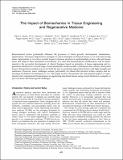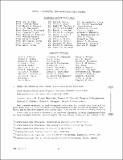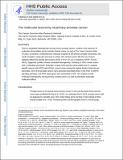The Impact of Biomechanics in Tissue Engineering and Regenerative Medicine
Author(s)
Butler, David L.; Goldstein, Steven A.; Guldberg, Robert E.; Guo, X. Edward; Kamm, Roger Dale; Laurencin, Cato T.; McIntire, Larry V.; Mow, Van C.; Nerem, Robert M.; Sah, Robert L.; Soslowsky, Louis J.; Spilker, Robert L.; Tranquillo, Robert T.; ... Show more Show less
DownloadButler-2009-The Impact of Biomec.pdf (362.5Kb)
PUBLISHER_POLICY
Publisher Policy
Article is made available in accordance with the publisher's policy and may be subject to US copyright law. Please refer to the publisher's site for terms of use.
Terms of use
Metadata
Show full item recordAbstract
Biomechanical factors profoundly influence the processes of tissue growth, development, maintenance, degeneration, and repair. Regenerative strategies to restore damaged or diseased tissues in vivo and create living tissue replacements in vitro have recently begun to harness advances in understanding of how cells and tissues sense and adapt to their mechanical environment. It is clear that biomechanical considerations will be fundamental to the successful development of clinical therapies based on principles of tissue engineering and regenerative medicine for a broad range of musculoskeletal, cardiovascular, craniofacial, skin, urinary, and neural tissues. Biomechanical stimuli may in fact hold the key to producing regenerated tissues with high strength and endurance. However, many challenges remain, particularly for tissues that function within complex and demanding mechanical environments in vivo. This paper reviews the present role and potential impact of experimental and computational biomechanics in engineering functional tissues using several illustrative examples of past successes and future grand challenges.
Date issued
2009-12Department
Massachusetts Institute of Technology. Department of Mechanical EngineeringJournal
Tissue Engineering. Part B
Publisher
Mary Ann Liebert, Inc.
Citation
Butler, David L. et al. “The Impact of Biomechanics in Tissue Engineering and Regenerative Medicine.” Tissue Engineering Part B: Reviews 15.4 (2009): 477-484. ©2009 Mary Ann Liebert, Inc.
Version: Final published version
ISSN
1937-3368
Collections
Related items
Showing items related by title, author, creator and subject.
-
Cognitive Information Processing
Allen, Jonathan; Hunnicutt, M. Sharon; Carroll, Francis X.; O'Shaughnessy, Douglas; Goldhor, Richard C.; e.a. (Research Laboratory of Electronics (RLE) at the Massachusetts Institute of Technology (MIT), 1976-01) -
The Molecular Taxonomy of Primary Prostate Cancer
Abeshouse, Adam; Ahn, Jaeil; Akbani, Rehan; Ally, Adrian; Amin, Samirkumar; e.a. (Elsevier, 2015-11)There is substantial heterogeneity among primary prostate cancers, evident in the spectrum of molecular abnormalities and its variable clinical course. As part of The Cancer Genome Atlas (TCGA), we present a comprehensive ... -
Optical Propagation and Communication
Shapiro, Jeffrey H.; Nguyen, Trung T.; Wong, Albert K.; Tran, Hai V.; Bounds, Jeffrey K.; e.a. (Research Laboratory of Electronics (RLE) at the Massachusetts Institute of Technology (MIT), 1985-01)


